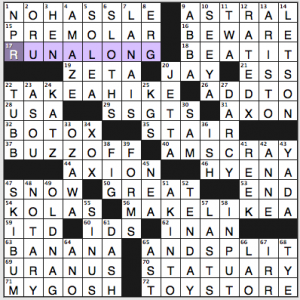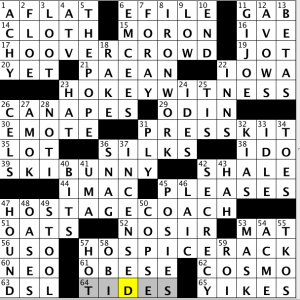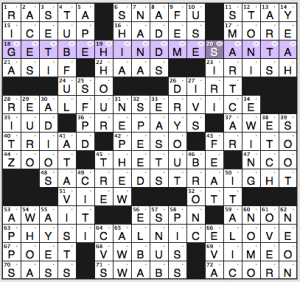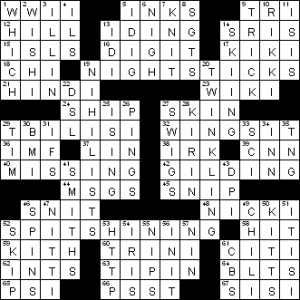NYT 3:57 (Amy)
Tausig untimed (Amy)
LAT 3:50 (Gareth)
CS 5:57 (Dave)
Still wondering what was up with the Tuesday NYT? Here’s the explanation. The first letters of all the clues spelled out various colors and animals, and those tied in with an illusion that constructor/magician David Kwong did at his TED Talk on Tuesday. So the primary audience for his puzzle would appear to be his amazed lecture attendees rather than us solvers.
Sam Donaldson’s New York Times crossword
Oh, hi, Sam! Look, everyone: It’s Team Fiend’s resident wag, Sam Donaldson, in the byline of the NYT puzzle. The theme is slangy ways to tell someone to get the hell outta here, clued with apt recipients:
- 17a. [Go away as a marathoner might?], RUN ALONG.
- 18a. [Go away as a Michael Jackson impersonator might?], BEAT IT.
- 22a. [Go away as an outdoorsman might?], TAKE A HIKE.
- 37a. [Go away as a bumblebee might?], BUZZ OFF.
- 40a. [Go away as a speaker of pig Latin might?], AMSCRAY.
- 56a, 63a, 65a. [With 63- and 65-Across, go away as a soda jerk might?], MAKE LIKE A / BANANA / AND SPLIT. I’m more familiar with “make like a tree and leave.”
Cute. But an eight-piece theme means some compromises in the fill. I do like NO-HASSLE, PREMOLAR (what? I used to be a dental editor), MY GOSH, TOY STORE, SKI BUM, RATED X, Austen’s DARCY, and even TEN-DAY (topically clued as 52d. [Like some short-term N.B.A. contracts]—Jason Collins was recently signed to two successive 10-day Nets contracts before they signed him for the rest of the season; before Collins was signed as the first openly gay NBA player, I’d never heard of this 10-day contract idea, and I would have thought this answer was lame). The trade-offs are as follows:
- The unfamiliar SOLEA, 5d. [Form of flamenco]. Did many of you know this word? Seems tough for a Wednesday, but maybe the rest of you are flamenco aficionados who knew the word.
- Partial A SOU, 23d. [Not worth ___].
- Wildly unfamiliar AXION, 44a. [Particle theorized in 1977]. Maybe the rest of you know your theoretical particle physics along with your flamenco?
- 65d. [Prince Edward Island hrs.], AST. Atlantic Standard Time.
- 34d. [Worthless tic-tac-toe row], XOX. Meh.
- Plus ESS, IN AN, IT’D, IRR, LAO, SSGTS, TYE, A NO, ISH, ORU …
We all strike our own balance in terms of the importance of theme, the value of juicy fill, and the degree to which blah fill affects our enjoyment of the puzzle. This one had an innately entertaining theme (it’s mouthy! and it makes us see colloquialisms in the fresh light of Sam’s brain) and it had a lot of good fill, but bits like SOLEA and AXION do tend to take me out of my Happy Solver Headspace. So I will park myself at the 3.75 stars level for this one.
Raymond Hamel’s CrosSynergy / Washington Post crossword, “Hi Ho” – Dave Sullivan’s review
Today’s CS/WaPo asks us to say “hi” to the letters HO four times, added to the beginning of phrases:
- To “overcrowd” gets the HO treatment with [Fans of the 31st President?] cluing HOOVER CROWD – do they have secret decoder rings and a special handshake?
- A “key witness” becomes [Phony court figure?] or a HOKEY WITNESS – the Trayvon Martin trial comes to my mind when I hear this phrase.
- [Bus for prisoners?] was HOSTAGE COACH – are prisoners necessarily hostages? I think of prisoners as being convicted of something, whereas hostages are guilty of nothing but being in the wrong place at the wrong time. OTOH, if one thinks of prisoners as those held against their will, the clue is spot on.
- [Shelter storage?] clued a HOSPICE RACK – hospices have taken on a modern definition of places people who are terminally ill go to live out their last days with family and friends, eschewing aggressive medical treatments. We had a friend at one last year who died of adrenal cancer at the tender age of 48.
My first thought when reading the title was that HI would be added to the first word of two-word phrases and HO to the second, but that would be a much more ambitious (perhaps impossible?) theme seed. I’m not a big fan of arbitrary articles (a slippery slope to be sure), but I do like THE POPE since if anyone’s going to get a definite article around here, he’d be on my Top Ten list. COPSE or a [Bushy thicket] is an unusual word, it’s an alteration of “coppice,” which traces its roots to the French couper or to cut. Timely entry for [Fracking target] or SHALE as many communities are debating the ecological risks of injecting water at high pressure into shale to free the imbedded oil. Finally, I enjoyed seeing SKI BUNNY in today’s puzzle as I had just spent the day skiing yesterday.
Ben Tausig’s Chicago Reader/Ink Well crossword, “Upbeat Mixes”
The “Upbeat Mixes” in this theme are unpleasant words anagrammed into happier ones to convert familiar phrases into goofy ones. The parentheticals hint at the original pre-scrambled words:
- 18a. [Blitzen’s seating instruction to his sleigh driver? (No dark forces at work here!)], GET BEHIND ME, SANTA! No need for Satan.
- 28a. [What a goofy, witty waitstaff provides? (Everyone is alive and well)], REAL FUN SERVICE. No more funeral.
- 48a. [The holiest of poker hands? (You screaming convicts can relax)], SACRED STRAIGHT. No “Scared Straight.”
- 63a. [Tender hugs and kisses, e.g.? (No hitting!)], PHYSICAL NICE LOVE. Much nicer than violence.
Two negative terms at the beginning, two at the end: good balance. 18a and 48a are kinda funny, and 63a sounds like something you’d tell a toddler to practice. A theme that’s at least half-funny is much more successful than a theme whose wordplay provides very little actual amusement.
Six more things:
- 52a. [Outrageous, briefly], OTT. Short for “over the top.” Gareth has been using this in his comments but it was test-solving this puzzle that taught me what it meant.
- 45a. [It includes Piccadilly and Victoria lines], THE TUBE. London’s subway system. Great entry.
- 69a. [Online clip-sharing site whose name is an anagram of MOVIE], VIMEO. Huh! Never noticed that. Wikipedia says, “The name Vimeo was created by Lodwick, as a play on the words video and me. Vimeo is also an anagram of the word movie.”
- 8d. [Drops in the bucket, perhaps], ADDS. Literally, as a verb. Not metaphorically as a noun, “just a drop in the bucket.”
- 20d. [“___, find me a crossword clue for yourself”], SIRI. Cute!
- 31d. [Jason Sudeikis, to George Wendt], NEPHEW. Trivia! Did not know this.
Solid fill, crisp clues, fun theme. Four stars.
Jeff Chen & Jim Horne’s Los AngelesTimes crossword – Gareth’s review
So this is the 3rd big central letter gimmick puzzle of the year for the LA Times. Strange. Here are links to puzzles 1 (by the same duo) and 2 (by Bruce Haight) if your memory needs refreshing. This one is the opposite of Horne & Chen’s E puzzle, but similar to Haight’s H puzzle, only not quite as tightly defined. There, every answer had an “H”, here answers either have no vowels or only I’s as vowels.
Not as much awkwardness as I anticipated approaching the puzzle. The worst moment was ISLS/ILS and that was right at the beginning! There were even a few neat answers like TBILISI, SPITSHINING, and WINGSIT. I have a personal affinity for TRINI, since I grew up with him amongst my mother’s 7 singles. WISHI [Words often heard before may and might] is contrived but at least cleverly clued.
3 Stars
Gareth, leaving you with this…




Completely blanked at SNOW (I’ve never heard it used in this sense) and KOLAS (familiar but not on the top of my brain). Equally unknown were AXON and AXION, but the crosses worked themselves out. A medium-challenging Wednesday for me (DNF – sad face), really enjoyed the theme phrases though!
Just read yesterday’s entertaining thread and now I know why so many people hate magicians.
Signed,
Avg Solvr (Or am I really Sarah Bwahahahahahahah)
I, too, just read yesterday’s comments about the Kwong puzzle and, like Zulema, I was entirely baffled by most of the posts. I checked out the links provided by ahimsa and was finally able to make sense of the magic trick associated with the puzzle. Big deal — it didn’t enhance my solving experience.
Was there some hint in yesterday’s puzzle that indicted that connection? Why would anyone try to find a message hidden in the first letters of each clue, without such a hint? Although I thought many of Sarah’s comments were tersely weird, I’d have to agree with her that she must “be the smartest person in the entire world”, if she figured it without some hint.
What I still don’t understand is how this magic tick association justified the unappreciated fill that seemed to account for its poor rating or, as JanglerNPL put it, “All of these clue shenanigans still don’t explain the junk in the grid, however.”
In the past, early-week puzzles didn’t generate much comment. Now they seem to the focus of all that’s “wrong” with crosswords, especially the NY Times puzzles.
Who hates magicians and are there really “many” of them?
I’ll say in sum: There was no reason to publish that puzzle if it was limited to a discussion panel, when he could have created it for the sole purpose of that event.
David Kwong does some amazing things, and it’s a shame we only got to experience a vague sense of it.
This left us with a dangling puzzle with a meta we could not hope to solve, and an overall dispiriting experience. I surmise that a large percentage of solvers would not notice the difference, and this is perhaps why it ran in print anyway.
Just disappointed with the decision and the experience. That is all, carry on with Wednesday, which is a perfectly fine, fun puzzle :).
What? Are we on a twenty-four hour news cycle? I think there’s still plenty to be said about yesterday’s strange cruciverbal magic trick, although I have noticed that threads on this blog rarely, if ever, carry on to the next day. Is that some kind of cyber protocol I’m not familiar with? If not, I’d still like to know if a hint was provided.
I’d also like to know why Sarah thought Evan’s post was “ironic” and why she expected him to know why.
Quick correction: Sarah wasn’t responding to my comment that you’re referring to, but Ethan’s. And I also don’t see the “irony” in it either.
The irony was stating that there was “too much theme”, when he wasn’t aware of all the thematic elements. Unfortunately, the rest of the theme involved a magic show that over 99.9% of NYT crossword solvers couldn’t hope to see. I apologize for leading some of the people on these blogs on. I had no idea at the time that the NYT crossword would sacrifice itself for such a personal matter.
May 31, 2005: Merl Reagle oddly constructs a Tuesday puzzle with a two word theme across the middle “WORD PLAY.” Solvers would have no way of knowing it is tied to an upcoming documentary.
Nov 16, 2008: Merl again, this time with a tie in to the Simpsons episode appearing the same day.
I am not equating the quality of these puzzles, just the fact that an external reference is not unknown. Until I see the full video, I am deferring judgment on Tuesday’s puzzle.
What video are you guys waiting for?
In each of the examples cited above, the puzzles stood on their own without the “hidden” content, suited to the Times style. The external content added to the puzzle.
In this case, the puzzle actually needed the additional content, because without, it’s honestly an uneven, strangely designed puzzle (which I could not complete, personally). I think there may be constructors who have had better puzzles (compared to the published content here) rejected. This one did not hold up as a Times-level puzzle on its own. The fill was compromised by the external requirements, even moreso than the Sunday Reagle Simpsons puzzle (which was relatively strong, Reagle-style).
Agree with Howard. I have no problem when Will Shortz uses the NYT to complement something happening externally. In addition to the two Jeffrey mentioned, there’s Byron Walden’s wedding day puzzle, the proposal in 1998, Kevin Der’s Friday puzzle this year that tied in to the MIT Mystery Hunt, and others.
The difference is that Tuesday’s puzzle (by itself) was way below par for the NYT, unlike the other examples.
As I said, I wasn’t comparing quality. Seems to me an unfortunate intersection of 3 events occured:
1) A non-Tuesday Tuesday. Nobody likes not being able to solve a Tuesday.
2) A puzzle that doesn’t stand alone well.
3) Lack of information about the external tie-in, so we can’t assess if 1 and 2 were worth it.
Agree with Dan F. Kevin’s Mystery Hunt puzzle was a good themeless puzzle for those of us who weren’t in the know. That it succeeded as a Friday NYT while secretly harboring Hunt clues only makes it neater. Yesterday’s puzzle didn’t hit the sweet spot for a great many solvers.
That was the disappointing part for me. I spent way too long yesterday staring at that puzzle trying to figure out what the meta was all about. Thought there was something in it.
There was, and I appreciate the trick, but I wish the rest of us had been alerted somehow that the puzzle was intended to tie in with the TED talk so we didn’t spend so much time racking our brains.
I have a book on how to play flamenco guitar, and I’ve never heard of SOLEA. Will have to look it up.
I can’t quite figure why the top left of the NYT gave me so much trouble now that I see the answers. I lost an extra few minutes just trying to piece together any of the longer acrosses up there.
Solea Flamenco — Well . . . You asked.
I’m not even close to an authority on Spanish Flamenco, or its cousin, the even more intense Portuguese Fado. But . . . There are various styles or forms of flamenco — I think called “palos” in Spanish. (Maybe Zulema can weigh in.) Each is characterized by slightly different chord progressions and cadences, different rhythmic stresses (i.e. different strong and weak beats, sometimes quite irregularly,) and different poetic meters and rhythms in the lyrics. Solea flamenco is the most basic, Andalusian flamenco form. It is what you intuitively hear and think of if you are at all familiar with flamenco.
The basic characteristic of flamenco is that it is in the phrygian mode, or some variation thereof in various palos. What does phrygian mode mean? “Mode”, when applied to a musical scale refers to the distribution of half and whole tones within the scale. The basic characteristic of the phrygian mode is a half step between the first and second tones of the scale. The first two notes in a scale starting on the note ‘E’ are E, F, not E, F sharp as would be the case in most major and minor scales.
If you have a keyboard, guitar, or pretty much any instrument which will produce chords, you can create some instant solea flamenco:
Play the notes C sharp, D, E . . . C sharp, D, E, F, E . . . Stress each of the E’s, and give them twice the duration (e.g. call them half notes rather than quarter notes.) Now play an A Major chord under the E’s and a B flat major chord under the F. Voila — Instant rudimentary solea flamenco. (It’s the half step between the A Major and B flat major chords which creates the characteristic phrygian solea flamenco sound.)
Wow, it’s a whole world out there of music that I know nothing about. It’s wonderful to have a resident expert.
Bruce, you might be interested to know that they have recently discovered some genes that are relevant to musical talent. Right there at the very first step of sound processing from the inner ear to the brain
http://www.the-scientist.com/?articles.view/articleNo/39422/title/Music-on-the-Mind/
Just thought I should add — I saw a Fado performance when I was in Portugal last summer. Every local person that my wife and I asked told us that we had to see one if we really wanted to understand Portuguese music and culture, and that it’s not uncommon for concertgoers to leave in tears. We didn’t cry, but it was a pretty fun show with some really cool 12-string guitar riffs.
Thanks for the extra information, Bruce. What little I know about dance could probably be written on a post-it note. So I enjoy learning new things from puzzles and from comments like yours.
I have heard SOLEA and of SOLEA and that is the extent of my acquaintance with the term. Just a listener and not a knowledgeable one at that.
But today’s puzzle was enjoyable. As for the colored animals in yesterday’s NYT is there a reason for them or their colors? Why is it being called a themeless since it had the “arms” to put in (or take out) and most of the theme entries made little sense on their own?
Regular Phrygian Mode has a minor third, but the typical scale used in Flamenco has a major third so it is variously known as Spanish Phrygian, Phrygian major or Phrygian dominant, and is a mode of the harmonic minor scale. The distinctive sound comes from that half-step you mentioned and also the augmented second that is in the Flamenco scale between the flat second and the major third.
Yes — spot on. I didn’t want to get too abstruse. As klew says, another typical flamenco motif might be, e.g.: E, F, G+, A, G+, F, F, E, with a ritardando and pause on the penultimate note — the F, cadencing downward to the tonic E. And under that last F, play an E *Major*, (not e minor) chord. The E Major chord uses the G# major third, and playing it with the F creates a dissonant “suspension” — i.e. the “unstable”, “active” non-chord tone F resolving downward to the consonant E Major triad.
AXIONs occupy a rather esoteric corner of particle physics. They are entirely conjectural, so there’s a possibility they don’t even exist. On the other hand, there’s a plausible hypothesis that ‘dark matter’ is composed of axions and an experiment is underway to test that hypothesis:
http://en.wikipedia.org/wiki/Axion_Dark_Matter_Experiment
So, it’s possible that axions will be very famous someday– just not yet.
I didn’t know that KGS would be on a British scale.
I think you’re getting the CGS scale (ergs etc.) mixed up with a British (or basically anywhere else) scale displaying kilograms (KGS) rather than the LBS used by America, Liberia, and somewhere else, I forget where…
To be fair, all of the UK people I know use the term “stone” when referring to weight.
True that…
It’s kinda bogus to tack an S onto the end of abbreviated weight units. It’s 2,000 lb, 150 kg, 16 oz, and so on. 1 stone = 14 lb. I rather like the stone system. Americans can obsess over gaining a single pound, but you have a ways to go before you increase your weight by 1 stone.
It may be true that formally you don’t write the s, but I just Googled the phrase “lose the lbs fast” (in quotes) and came up with over a thousand hits. So I think LBS is in use, informally.
Yeah, but watch out for those pebbles!
Thank heavens for a simple, colloquial theme! Impressive that the big (by themed standards) stacks have NOHASSLE/PREMOLAR and STATUARY/TOYSTORE! Could do without awkw. ASOU and XOX but or two of those are par for the course! Never heard of SOLEA but it seems a legitimately well-known answer. I think if it were up to me I’d have used AXIOM/MEA than AXION/NEA, that crossing didn’t bother me much though.
This former physics major had never heard of AXION. From what I can surmise, it’s still a purely hypothetical particle, in a field (quantum chromodynamics) that typically only gets covered in graduate-level physics.
I raised a bit of an eyebrow at the description of Mr. DARCY as “protagonist”. Looks like Wikipedia does describe him as “the male protagonist”, vs Elizabeth as “the protagonist”. But honestly, he’s the love interest of the protagonist, not the protagonist himself!
NYT: Enjoyable puzzle with so many of fun phrases!
I chuckled at having both AXON and AXION in the grid. A lot of those particle names seem to stick in my mind (love the word gluon) so for some reason AXION was not too hard for me. It doesn’t mean I actually know anything about it! It just means that I must have read it somewhere online and remembered the word.
LAT: I enjoyed this puzzle. I don’t mean just admiration for the trick and the big I in the grid. I actually had fun solving it. Too bad others didn’t have much fun with it.
I’m with you! I thought it was great fun.
It reminded me of Robert Morris’ self-protrait. He built a large box, of sorts, that had a hinged lid shaped like the upper class letter “I”. The inside of the box followed the same outline. He placed it in an upright position, such that the lid now looked more like a door, and posed naked in the opening. I still get a chuckle out of it. I have a .jpeg of it, but I don’t know how, or if it’s possible, to post it.
Hey, folks. Did you hear the big news in astrophysics this week, the evidence that the Big Bang really did kicked off with a rapid expansion universe and it’s more than just a neat theory? Andrei Linde, one of the coauthors of a seminal ’80s paper on the Big Bang Theory, answered the door to find another scientist on his front porch, there to share the news that Linde was right all along. (He brought Champagne.) Fiend commenter @Papa John thought you’d enjoy seeing the video, which is here along with a short explanatory article.
Based on my Facebook travels this week, this video pretty much went viral. Not a lot of astrophysics things go viral, you know.
Very cool, Amy. Hopefully we should get more info within the next five or so years, thanks to a satellite project which is supposed to be launching specifically to pick up more gravitational waves, and therefore teach us even more about the first second of our universe. The LISA project, which hopefully will go through even though the US might cut funding.
The good news: now we know the meta from yesterday. The bad news: ditto.
About yesterday’s New York Times puzzle, I never enjoy or notice themes inside the clues themselves that are unrelated to the crossword, such as in this case or using the same letter throughout to begin the clues or alphabetical order for all the clues. I think like most people I am intent on filling the grid. But I think that was just a private joke, and it didn’t interfere with my great enjoyment of the puzzle itself. I didn’t notice the straining in the clues to complete the subtheme, though it might have existed. I like to enjoy a puzzle, I don’t care about day of the week.